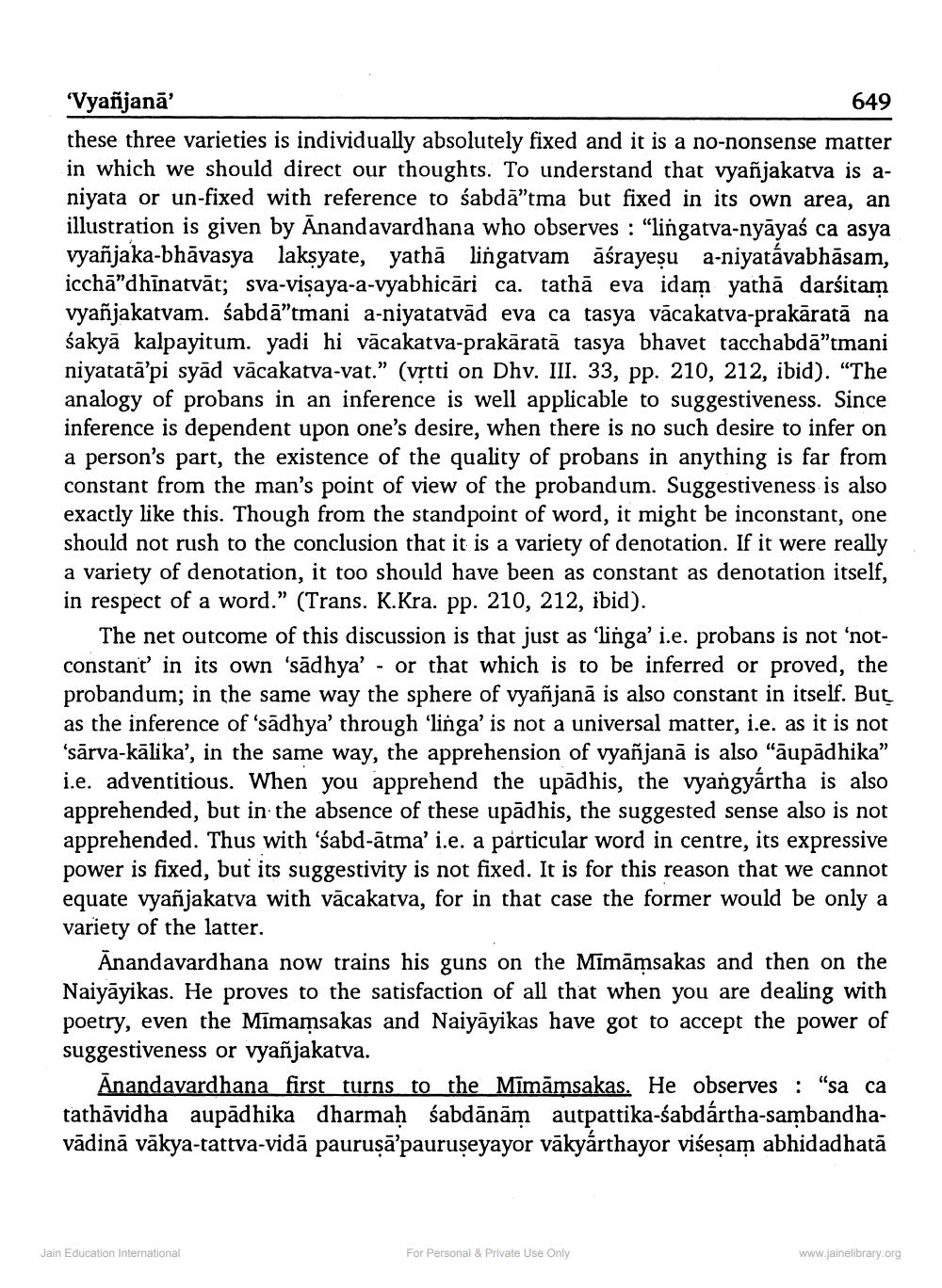________________
'Vyañjana'
649 these three varieties is individually absolutely fixed and it is a no-nonsense matter in which we should direct our thoughts. To understand that vyañjakarva is aniyata or un-fixed with reference to śabda"tma but fixed in its own area, an illustration is given by Anandavardhana who observes : “lingatva-nyāyaś ca asya vyañjaka-bhāvasya laksyate, yathā lingatvam āśrayeșu a-niyatávabhāsam, icchā”dhīnatvāt; sva-vișaya-a-vyabhicāri ca. tathā eva idam yathā darśitam vyañjakatvam. sabdā"tmani a-niyatatvād eva ca tasya vācakatva-prakāratā na sakyā kalpayitum. yadi hi vācakatva-prakāratā tasya bhavet tacchabdā”tmani niyatatā'pi syād vācakatva-vat." (vrtti on Dhv. III. 33, pp. 210, 212, ibid). "The analogy of probans in an inference is well applicable to suggestiveness. Since inference is dependent upon one's desire, when there is no such desire to info a person's part, the existence of the quality of probans in anything is far from constant from the man's point of view of the probandum. Suggestiveness is also exactly like this. Though from the standpoint of word, it might be inconstant, one should not rush to the conclusion that it is a variety of denotation. If it were really a variety of denotation, it too should have been as constant as denotation itself, in respect of a word." (Trans. K.Kra. pp. 210, 212, ibid.
The net outcome of this discussion is that just as 'linga' i.e. probans is not 'notconstant in its own 'sādhya' - or that which is to be inferred or proved, the probandum; in the same way the sphere of vyañjanā is also constant in itself. But as the inference of 'sādhya' through 'linga' is not a universal matter, i.e. as it is not 'sārva-kālika', in the same way, the apprehension of vyañjanā is also "āupādhika" i.e. adventitious. When you apprehend the upādhis, the vyangyártha is also apprehended, but in the absence of these upādhis, the suggested sense also is not apprehended. Thus with 'sabd-ātma' i.e. a particular word in centre, its expressive power is fixed, but its suggestivity is not fixed. It is for this reason that we cannot equate vyañjakatva with vācakatva, for in that case the former would be only a variety of the latter.
Ānandavardhana now trains his guns on the Mimāmsakas and then on the Naiyāyikas. He proves to the satisfaction of all that when you are dealing with poetry, even the Mimamsakas and Naiyāyikas have got to accept the power of suggestiveness or vyañjakatva.
Anandavardhana first turns to the Mimāmsakas. He observes : "sa ca tathāvidha aupādhika dharmaḥ śabdānām autpattika-sabdártha-sambandhavādinā vākya-tattva-vidā pauruşā’pauruseyayor vākyárthayor visesam abhidadhatā
Jain Education Interational
For Personal & Private Use Only
www.jainelibrary.org




